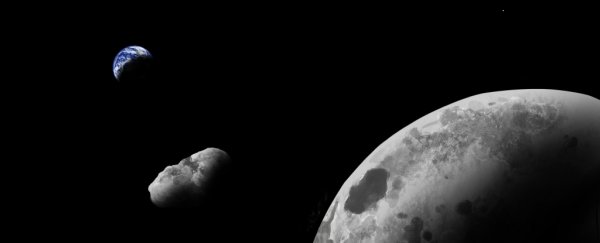It appears that our Moon has been careless.
According to a new analysis, a chunk of rock that hangs out near Earth's orbital path along the Sun seems to be made of the same material as the Moon, suggesting that it broke off at some point to be flung into space. But how, and when, remains a mystery.
The rock is named 469219 Kamoʻoalewa, and astronomers already found it interesting before this latest development.
The object belongs to a class of asteroids known as the Apollo asteroids, which more or less share Earth's orbit around the Sun; but Kamoʻoalewa is also what is known as a quasi-satellite, staying near Earth over long periods and multiple orbits.
Kamoʻoalewa is small, just 46 to 58 meters or so in diameter (150 to 190 feet), and can only be seen in Earth's sky for a few weeks every April. It wasn't discovered until 2016, and learning more about it hasn't been easy.
In this most recent effort to learn more, researchers made use of one of the most powerful telescopes on Earth, the Large Binocular Telescope at Mount Graham International Observatory. In 2017, they obtained observations that included the asteroid's spectrum – the distinct pattern generated by the way Kamoʻoalewa reflects light from the Sun.
The initial results showed that Kamoʻoalewa has a spectrum very similar to that generated by lunar rocks returned by the Apollo missions – and nothing like any other asteroids. This implies that the asteroid is made of the same stuff the Moon is made of, which made the researchers wonder: what the actual heck.
"I looked through every near-Earth asteroid spectrum we had access to, and nothing matched," said astronomer Ben Sharkey of the University of Arizona.
When you run across something weird, the obvious thing to do is collect more data. For Kamoʻoalewa, this was easier said than done – not just because of its limited viewing window, but because the COVID-19 global pandemic resulted in reduced telescope operations in observatories around the world, including Mount Graham.
It wasn't until April this year that the researchers were able to take to the skies and collect more observations of the mysterious rock. And those observations were consistent with their earlier findings – that, for some reason, Kamoʻoalewa reflects light more like the Moon than any other asteroids.
Now, there are several possible explanations for Kamoʻoalewa's origin. One possibility is that it was captured into its current orbit from a population of other asteroids.
This, according to the researchers, is unlikely: Kamoʻoalewa's orbit, unlike that of other asteroids, deviates very little from the plane of Earth's orbit. So not only does Kamoʻoalewa have the same orbital period as Earth, it has a very similar orbital inclination.
"It is very unlikely that a garden-variety near-Earth asteroid would spontaneously move into a quasi-satellite orbit like Kamoʻoalewa's," says planetary scientist Renu Malhotra of the University of Arizona.
"It will not remain in this particular orbit for very long, only about 300 years in the future, and we estimate that it arrived in this orbit about 500 years ago."
Another possibility is that Kamoʻoalewa originated in an as-yet undiscovered population of near-Earth asteroids, hanging out in a gravitationally stable region of Earth's orbit known as a Lagrangian point. To determine if this is the case, we're going to have to find evidence of this population of asteroids.
By far the best fit – given the currently available information – is that Kamoʻoalewa originated in the Earth-Moon system, either a chunk that broke off in a lunar impact event (pretty plausible, given how covered in impact craters our satellite is) or an asteroid that drew too close to Earth and the Moon, and was broken apart by gravitational interactions.
Given Kamoʻoalewa's spectrum, however, for now the Moon chunk scenario seems most apt, according to the researchers.
The study has been published in Nature Communications.
